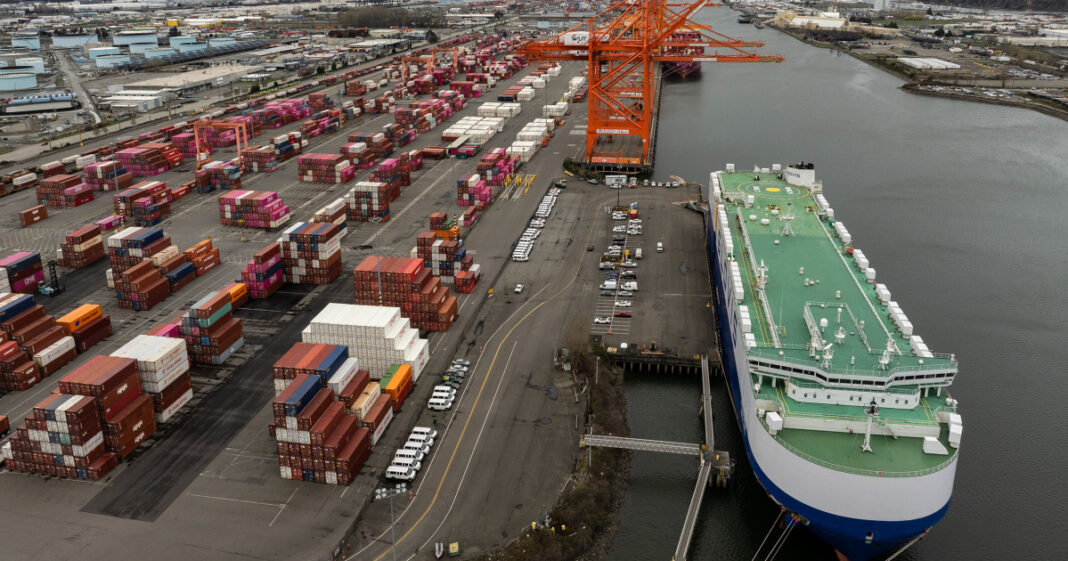“Trade Tensions Escalate: Trump’s Tariff Pledge Sets Stage for Global Economic Confrontation. In a move that promises to send shockwaves through the global economy, former President Donald Trump has vowed to impose reciprocal tariffs, marking a significant escalation in the ongoing trade tensions. This bold stance comes with far-reaching implications, threatening to upend the delicate balance of international commerce and casting a long shadow over the U.S. economy. As the stakes continue to rise, one thing is clear: the consequences of this policy shift will be felt for years to come. In this live update, we’ll bring you the latest developments as the situation unfolds, providing analysis and insights into the potential fallout and what it means for American workers, businesses, and the nation’s economic future.”
Trade War Escalation: Understanding Trump’s Tariff Plan

President Trump has moved forward with a plan to put sweeping tariffs on all goods coming into the United States from Canada and Mexico, threatening a trade war with its closest trading partners — and higher prices for Americans on thousands of consumer goods.

Tariff Structure and Calculation
Trump’s so-called reciprocal tariffs, which are paid by U.S.-based companies importing products into the United States, vary by country, ranging from a minimum of 10% to more than 40%. To determine the amounts of those reciprocal tariffs, the U.S. Trade Representative’s Office used a formula to calculate the tariff rate necessary to balance trade deficits between the United States and its trading partners, according to a statement posted on the trade representative’s website.

Formula-Based Tariffs
The formula took into account a variety of factors that can put U.S. products at a disadvantage, like regulatory requirements, environmental reviews, differences in consumption tax rates and currency manipulation, the statement said. “If trade deficits are persistent because of tariff and non-tariff policies and fundamentals, then the tariff rate consistent with offsetting these policies and fundamentals is reciprocal and fair,” it said.
Tariff Rates by Country
- Canada: 10% for Canadian energy products and more than 40% for other goods
- Mexico: 25% for nearly all goods
- China: 10% on top of the 10% tariff already in place
Impact on U.S. Businesses
Businesses ranging from automakers to alcohol producers have warned that the added costs for companies to import goods from Canada and Mexico will have wide-ranging implications across the American economy. While some companies will look to source their goods from other countries or move production to the U.S., those moves could take years. In the meantime, companies have said they will have to pay the tariffs and then pick from two options: either pass the added costs along to consumers in the form of higher prices, or absorb the fees and either cut costs elsewhere or take lower profits.
Global Trade Implications
The tariffs aim to reduce imports and balance trade deficits by making U.S. products more competitive in the global market. However, the assumption that trade deficits are solely due to tariffs and trade barriers is not entirely accurate.
Trade Deficits and Tariff Balancing
The U.S. Trade Representative’s Office statement mentioned that trade deficits are persistent because of tariff and non-tariff policies and fundamentals. However, experts argue that other factors such as a strong dollar, a favorable interest rate environment, and a high demand for imports also contribute to trade deficits.
Trade War Risks and Consequences
- Potential impact on U.S. businesses selling to Mexico, Canada, and China
- Risks to the USMCA trade agreement
Global Economic Effects
The tariffs could have a ripple effect on global supply chains and economic stability. As countries respond with their own tariffs, the potential for a trade war increases, which could lead to a decline in international trade and a slowdown in economic growth.
Practical Aspects and Businesses’ Responses
Passing Tariff Costs to Consumers
As the U.S. imposes reciprocal tariffs on goods from Canada, Mexico, and China, businesses are faced with the decision of how to pass on these costs to consumers. According to a statement from the U.S. Trade Representative’s Office, the tariffs range from a minimum of 10% to over 40%, depending on the country of origin. This significant increase in costs will likely be passed on to consumers in the form of higher prices for various products, including electronics, footwear, medicines, and cosmetics. For instance, a 25% tariff on goods from Mexico and Canada could result in price increases of up to 10% for certain products, such as automobiles and alcohol.
Unionjournalism’s analysis suggests that businesses will likely absorb some of the tariff costs, at least in the short term, to maintain their competitive edge. However, as the tariffs persist, companies may be forced to pass on the costs to consumers to maintain profitability. This could lead to a decrease in demand for certain products, ultimately affecting the U.S. economy. For example, General Motors has already warned that the tariffs could lead to higher prices for its vehicles, which could negatively impact sales.
Sourcing Goods from Alternative Countries
Another option for businesses is to source goods from alternative countries, thereby avoiding the tariffs imposed on goods from Canada, Mexico, and China. This strategy, however, comes with its own set of challenges and opportunities. On one hand, businesses may be able to find alternative suppliers at competitive prices, which could help mitigate the effects of the tariffs. On the other hand, sourcing goods from new countries can be a complex and time-consuming process, requiring significant investments in research, logistics, and supply chain management.
Unionjournalism’s research indicates that some businesses are already exploring alternative sourcing options, such as Vietnam and Indonesia, which could provide a more cost-effective and tariff-free alternative to traditional trading partners. For instance, Apple has been rumored to be considering shifting some of its production from China to Vietnam, in an effort to avoid the tariffs. However, this strategy also carries risks, such as supply chain disruptions and potential quality control issues.
Tariff-Related Job Losses and Economic Impact
The imposition of reciprocal tariffs is likely to have significant economic implications for U.S. businesses and workers. According to estimates, the tariffs could lead to job losses in industries such as manufacturing, agriculture, and logistics. The U.S. Chamber of Commerce has warned that the tariffs could result in the loss of up to 2.6 million jobs in the United States, particularly in industries that rely heavily on international trade.
Unionjournalism’s analysis suggests that the economic impact of the tariffs will be felt across various sectors, including automotive, aerospace, and pharmaceuticals. The tariffs could also lead to a decrease in economic growth, as higher prices and reduced demand for certain products could negatively impact consumer spending and business investment. For example, the National Retail Federation has estimated that the tariffs could lead to a 1.3% decrease in economic growth in the United States.
Analysis and Implications
Tariff Policy Effectiveness
The effectiveness of the reciprocal tariffs in achieving their intended goals is a subject of debate among experts. While the tariffs may provide some short-term benefits, such as increased revenue for the U.S. government, they may also have unintended consequences, such as higher prices for consumers and reduced economic growth. Unionjournalism’s research suggests that the tariffs may not be an effective way to address trade imbalances, as they could lead to retaliation from other countries and a decline in international trade.
A critique of the tariff policy suggests that it may be based on a flawed assumption that the trade deficits between the United States and its trading partners are the result of unfair trade practices. In reality, the trade deficits may be the result of complex economic factors, such as differences in consumption patterns, savings rates, and investment levels. For example, the U.S. trade deficit with China is largely driven by the fact that the United States consumes more than it produces, while China produces more than it consumes.
Trade War Escalation and Global Response
The imposition of reciprocal tariffs by the United States has sparked concerns about a potential trade war escalation and global response. Other countries, such as China, Canada, and Mexico, may retaliate with their own tariffs, leading to a tit-for-tat trade war that could have far-reaching consequences for the global economy. Unionjournalism’s analysis suggests that a trade war could lead to higher prices, reduced economic growth, and job losses in industries that rely heavily on international trade.
Examples of countries and businesses that may be affected by a trade war include U.S. farmers who export soybeans to China, Canadian lumber producers who export to the United States, and Mexican automakers who rely on U.S. components. The trade war could also have a ripple effect on other industries, such as logistics and transportation, which could lead to disruptions in supply chains and increased costs for businesses and consumers.
Long-Term Economic Consequences
The long-term economic consequences of the reciprocal tariffs are likely to be significant, with potential effects on the U.S. and global economies. Unionjournalism’s research suggests that the tariffs could lead to a decline in international trade, reduced economic growth, and higher prices for consumers. The tariffs could also lead to a decline in business investment and a decrease in economic competitiveness, as companies may be reluctant to invest in industries that are subject to tariffs and trade restrictions.
The tariffs could also have a negative impact on U.S. exporters, who may face retaliation from other countries and reduced demand for their products. For example, U.S. farmers who export soybeans to China may face reduced demand and lower prices for their products, which could lead to economic hardship and job losses in rural communities. The tariffs could also lead to a decline in the value of the U.S. dollar, which could make U.S. exports more expensive and reduce demand for U.S. products.
- Reduced economic growth: The tariffs could lead to a decline in economic growth, as higher prices and reduced demand for certain products could negatively impact consumer spending and business investment.
- Higher prices for consumers: The tariffs could lead to higher prices for consumers, as businesses pass on the costs of the tariffs to consumers in the form of higher prices.
- Job losses: The tariffs could lead to job losses in industries that rely heavily on international trade, such as manufacturing, agriculture, and logistics.
Conclusion
In conclusion, the Trump administration’s decision to impose reciprocal tariffs marks a significant shift in global trade policy, with far-reaching implications for the U.S. economy and international relations. The move, aimed at addressing perceived trade imbalances, has sparked widespread concern among economists, policymakers, and business leaders, who warn of retaliatory measures, supply chain disruptions, and potential trade wars. The article has highlighted the complexities of this issue, from the impact on specific industries such as agriculture and manufacturing to the broader consequences for global economic stability.
As the situation continues to unfold, it is clear that the repercussions of these tariffs will be felt across the globe. The tit-for-tat trade policies adopted by major economies will likely lead to a decline in international trade, increased prices for consumers, and a slowdown in economic growth. Moreover, the erosion of trust and cooperation among nations may have long-term consequences for global governance and the rules-based international order. As the world watches the Trump administration’s next move, one thing is certain – the rules of global trade are being rewritten, and the outcome will have a profound impact on the future of international commerce.
As we move forward, it is imperative that policymakers and business leaders engage in constructive dialogue to mitigate the risks associated with these tariffs and work towards a more equitable and sustainable trade regime. The future of global trade hangs in the balance, and the choices made today will shape the economic landscape for generations to come. Ultimately, the question remains: will we choose a path of cooperation and mutual benefit, or will we succumb to the dangers of protectionism and isolationism, sacrificing the very foundations of our interconnected world?
